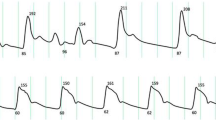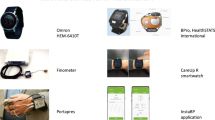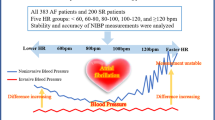Abstract
An oscillometric waveform (OMW) envelope-based blood pressure (BP) monitoring device is widely used to monitor blood pressure and prevent hypertension and adverse cardiovascular events. At present, all primary care physicians and clinicians widely recommend oscillometric-based BP devices. The consumer selects the device based on their own decision, without knowing whether the device is validated or not, resulting in over- or under-treatment of hypertension. It is imperative that each device must comply with international protocols. In this study, we have investigated the accuracy of inflation and deflation-based oscillometric BP monitoring devices in the case of sinus rhythm (SR). Since different health conditions of the patient affect the oscillometric waveform, which can affect the device’s accuracy, in such cases, many BP monitors are skeptical of succeeding in the norms of international protocols. Therefore, this study also aims to calculate the accuracy of these devices in various health conditions and measure the effect of pulse volume, arrhythmia, and respiratory artifact on it using a non-invasive blood pressure (NIBP) simulator. We found that the oscillometric BP devices failed to measure the correct blood pressure in several clinical conditions.
This is a preview of subscription content, access via your institution
Access options
Subscribe to this journal
Receive 12 digital issues and online access to articles
$119.00 per year
only $9.92 per issue
Buy this article
- Purchase on Springer Link
- Instant access to full article PDF
Prices may be subject to local taxes which are calculated during checkout






Similar content being viewed by others
Data availability
All data generated or analyzed during this study are included in this article.
References
Anchala R, Kannuri NK, Pant H, Khan H, Franco OH, Di Angelantonio E, et al. Hypertension in India: a systematic review and meta-analysis of prevalence, awareness, and control of hypertension. J Hypertens. 2014;32:1170–7.
Kumar R, Dubey PK, Zafer A, Kumar A, Yadav S. Past, present and future of blood pressure measuring instruments and their calibration. Meas J Int Meas Confed. 2021;172:108845.
Arima H, Barzi F, Chalmers J. Mortality patterns in hypertension. J Hypertens. 2011;29:3–7.
Forouzanfar M, Dajani HR, Groza VZ, Bolic M, Rajan S, Batkin I. Oscillometric blood pressure estimation: past, present, and future. IEEE Rev Biomed Eng. 2015;8:44–63.
Stergiou GS, Alpert B, Mieke S, Asmar R, Atkins N, Eckert S, et al. Consensus document a universal standard for the validation of blood pressure measuring devices association for the advancement of medical instrumentation / european society of hypertension/international organization for standardization. Hypertesion. 2018;71:1–8.
Ruzicka M, Akbari A, Bruketa E, Kayibanda JF, Baril C, Hiremath S. How accurate are home blood pressure devices in use? A cross-sectional study. PLoS One. 2016;11:1–11.
de Greeff A, Lorde I, Wilton A, Seed P, Coleman AJ, Shennan AH. Calibration accuracy of hospital-based non-invasive blood pressure measuring devices. J Hum Hypertens. 2010;24:58–63.
Padwal R, Jalali A, McLean D, Anwar S, Smith K, Raggi P, et al. Accuracy of oscillometric blood pressure algorithms in healthy adults and in adults with cardiovascular risk factors. Blood Press Monit. 2019;24:33–7.
Nelson D, Kennedy B, Regnerus C, Schweinle A. Accuracy of automated blood pressure monitors. J Dent Hyg. 2008;82:35.
O’Brien E, Waeber B, Parati G, Staessen J, Myers MG. Blood pressure measuring devices: recommendations of the European Society of Hypertension. Br Med J. 2001;322:531–6.
Sasaki J, Kikuchi Y, Usuda T, Hori S. Validation of inflationary noninvasive blood pressure monitoring in the emergency room. Blood Press Monit. 2015;20:325–9.
Takahashi K, Asai T, Okuda Y. Efficacy of a new blood pressure monitor inflationary non‐invasive blood pressure iNIBP: a randomised controlled study. Anaesthesia 2020;75:37–44.
Onodera J, Kotake Y, Fukuda M, Yasumura R, Oda F, Sato N, et al. Validation of inflationary non-invasive blood pressure monitoring in adult surgical patients. J Anesth. 2011;25:127–30.
Xie F, Xu J, Liu H, Li X, Wu Y, Su H. Different impact factors for accurate oscillometric blood pressure measurement between sinus rhythm and atrial fibrillation. J Hum Hypertens. 2021;35:785–90.
Halfon M, Wuerzner G, Marques-Vidal P, Taffe P, Vaucher J, Waeber B, et al. Use of oscillometric devices in atrial fibrillation: a comparison of three devices and invasive blood pressure measurement. Blood Press. 2018;27:48–55.
Su H, Guo Z. Accuracy of non-invasive blood pressure measurement in patients with atrial fibrillation. J Hum Hypertens. 2022;36:229–34.
Xie F, Xu J, Xia LL, Luo X, Jiang Z, Wu Y, et al. The impact of atrial fibrillation on accuracy of oscillometric blood pressure measurement: effect of ventricular rate. Hypertens Res. 2020;43:518–24.
Picone DS, Deshpande RA, Schultz MG, Fonseca R, Campbell NRC, Delles C, et al. Nonvalidated home blood pressure devices dominate the online marketplace in Australia: major implications for cardiovascular risk management. Hypertension. 2020;75:1593–9.
Sims AJ, Reay CA, Bousfield DR, Menes JA, Murray A. Oscillometric blood pressure devices and simulators: measurements of repeatability and differences between models. J Med Eng Technol. 2005;29:112–8.
Mieke S. Substitute-of-simulators-for-human-subjects. Blood Press Monit. 1997;2:251–6.
Ng K-G. Design and construction of an oscillometric blood pressure simulator. J Clin Eng. 1998;23:196–214.
Hoffmann-Petersen N, Newell SR, Brantlov S, Pedersen EB. Technical validation of Omron 705IT and A&D UA-767PlusBT using oscillometric waveform simulators. J Clin Eng. 2015;40:150–64.
Celler BG, Argha A, Le PN, Ambikairajah E. Novel methods of testing and calibration of oscillometric blood pressure monitors. PLoS One. 2018;13:1–14.
Augustynek M, Penhaker M. Non invasive measurement and visualizations of blood pressure. Elektro Elektrotech. 2011;10:55–8.
Amoore JN, Vacher E, Murray IC, Mieke S, King ST, Smith FE, et al. Can a simulator that regenerates physiological waveforms evaluate oscillometric non-invasive blood pressure devices? Blood Press Monit. 2006;11:63–7.
Kumar S, Bijender, Yadav S, Kumar A. Flexible microhyperboloids facets giant sensitive ultra-low pressure sensor. Sens Actuators A Phys. 2021;328:112767.
Kumar S, Yadav S, Kumar A. Oscillometric waveform evaluation for blood pressure devices. Biomed Eng Adv. 2022;4:100046.
Agostoni PG, Wasserman K, Perego GB, Guazzi M, Cattadori G, Palermo P, et al. Non-invasive measurement of stroke volume during exercise in heart failure patients. Clin Sci. 2000;98:545–51.
Convertino VA, Ludwig DA, Cooke WH. Stroke volume and sympathetic responses to lower-body negative pressure reveal new insight into circulatory shock in humans. Auton Neurosci Basic Clin. 2004;111:127–34.
Epstein D, Guinzburg A, Sharon S, Kiso S, Glick Y, Marcusohn E, et al. A noninvasive stroke volume monitoring for early detection of minimal blood loss: a pilot study. Shock 2021;55:230–5.
Klabunde RE. Cardiovascular physiology concepts. 2003; Available from: http://www.cvphysiology.com/index.html.
Pagonas N, Schmidt S, Eysel J, Compton F, Hoffmann C, Seibert F, et al. Atrial fibrillation impact of atrial fibrillation on the accuracy of oscillometric blood pressure monitoring. 2015;579–85.
Stergiou GS, Kollias A, Destounis A, Tzamouranis D. Automated blood pressure measurement in atrial fibrillation: a systematic review and meta-analysis. J Hypertens. 2012;30:2074–82.
Park SH, Choi YK. Measurement reliability of automated oscillometric blood pressure monitor in the elderly with atrial fibrillation: a systematic review and meta-analysis. Blood Press Monit. 2020;25:2–12.
Clark CE, McDonagh STJ, McManus RJ. Accuracy of automated blood pressure measurements in the presence of atrial fibrillation: systematic review and meta-analysis. J Hum Hypertens. 2019;33:352–64.
Wang XX, Shuai W, Hong K, Xu J, Li JX, Li P, et al. How to evaluate BP measurements using the oscillometric method in atrial fibrillation: the value of pulse rate variation. Hypertens Res. 2016;39:588–92.
Acknowledgements
The authors would like to thank the Director, CSIR-National Physical Laboratory, and the Head of the Physico-Mechanical Metrology Division for their support and necessary facilities. SK would like to thank AcSIR for allowing him to pursue the PhD program and CSIR for providing the student research fellowship.
Author information
Authors and Affiliations
Contributions
SK and AK conceptualized the problem. SK acquired the data and prepared the original manuscript. SY and AK investigated the problem, revised the manuscript and approved the final version.
Corresponding author
Ethics declarations
Competing interests
The authors declare no competing interests.
Ethical approval
In this work, NIBP simulators have been used instead of humans. Therefore ethical approval is not required.
Additional information
Publisher’s note Springer Nature remains neutral with regard to jurisdictional claims in published maps and institutional affiliations.
Rights and permissions
Springer Nature or its licensor (e.g. a society or other partner) holds exclusive rights to this article under a publishing agreement with the author(s) or other rightsholder(s); author self-archiving of the accepted manuscript version of this article is solely governed by the terms of such publishing agreement and applicable law.
About this article
Cite this article
Kumar, S., Yadav, S. & Kumar, A. Accuracy of oscillometric-based blood pressure monitoring devices: impact of pulse volume, arrhythmia, and respiratory artifact. J Hum Hypertens 38, 45–51 (2024). https://doi.org/10.1038/s41371-023-00856-4
Received:
Revised:
Accepted:
Published:
Issue Date:
DOI: https://doi.org/10.1038/s41371-023-00856-4



